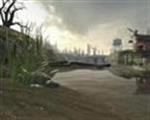ATI CrossFire Technology Showcase
We've already explained how ATI's 'Super-AA' modes work in our initial CrossFire Technology Preview, but we thought we'd give you all a quick refresher here as well. Essentially, Super-AA works by blending the frames rendered on each card together in the CrossFire Edition (Master) card's compositing engine. The end result is an effective increase in the number of samples used to anti-alias the scene.
|


The new Super-AA modes offered by CrossFire are 8X AA, 10X AA, 12X AA, and 14X AA. 8X Super-AA is the result of a blend of 4X multi-sample AA being used on each card, with each one using a different sample pattern. 12X Super-AA is very similar, but in this mode ATI's 6X multi-sample AA algorithm is used on each card, before they're blended together in the compositing engine. 10X AA and 14X AA, however, are somewhat different. In these modes, an additional level of anti-aliasing is applied to the image, in the form of 2X super-sample AA. Unlike MSAA, which only works on polygon edges, Super-Sample AA can reduce the appearance of jaggies in an entire scene, even on transparent textures like those used to simulate vegetation or a chain-link fence, for example. 10X Super-AA is basically 8X AA plus 2X super-sample AA, and 14X Super-AA is 12X AA plus 2X super-sample AA.
|
Before we got to the business of benchmarking X850 XT CrossFire, we spent some time analyzing its in-game image quality versus the best NVIDIA currently has to offer, a GeForce 7800 GTX SLI configuration. We used the "background 2" map in Half-Life 2 to get a feel for how each configuration's anti-aliasing algorithm's affected the scene...
Yes, we admit it, there is a lot to see here. But we thought it best to give you all an idea as to how each and every anti-aliasing mode affected the jaggies in this particular scene from Half Life 2. If you direct your attention to the water-tower and crane in the background of the image, the impact anti-aliasing has on image quality is readily apparent. In the "No AA" shots it seemed to us that the Radeons had the lowest detail, and had the most prominent "jaggies." Look closely at the ladder on the water tower and you'll notice parts missing in the Radeon shots that are there on the GeForce 7800 cards.
With 4X anti-aliasing enabled, the "jaggies" in the scene are cleaned up considerably, but it's extremely difficult to perceive any real differences in the images, even while zoomed. Although the cables on the crane seem slightly more defined on the Radeon cards to us. And as you move through the successive levels of anti-aliasing, the jaggies in the scene are further reduced. The most interesting modes offered by CrossFire, in our opinion, are 10x and 14x. In these modes, because 2x super-sampling is applied to the scene in addition to multi-sampling, transparent textures are anti-aliased as well. Take a look at the full scene and focus on the blades of grass and tree on the left. When 10x and 14x AA are used, those areas are also anti-aliased, which results in a much more realistic image.
If you compare the image quality of NVIDIA's SLI AA modes to ATI's Super-AA modes, you'll see that they each produce very similar images. Overall though, we'd give an edge to ATI, but it's a darn close call.




























